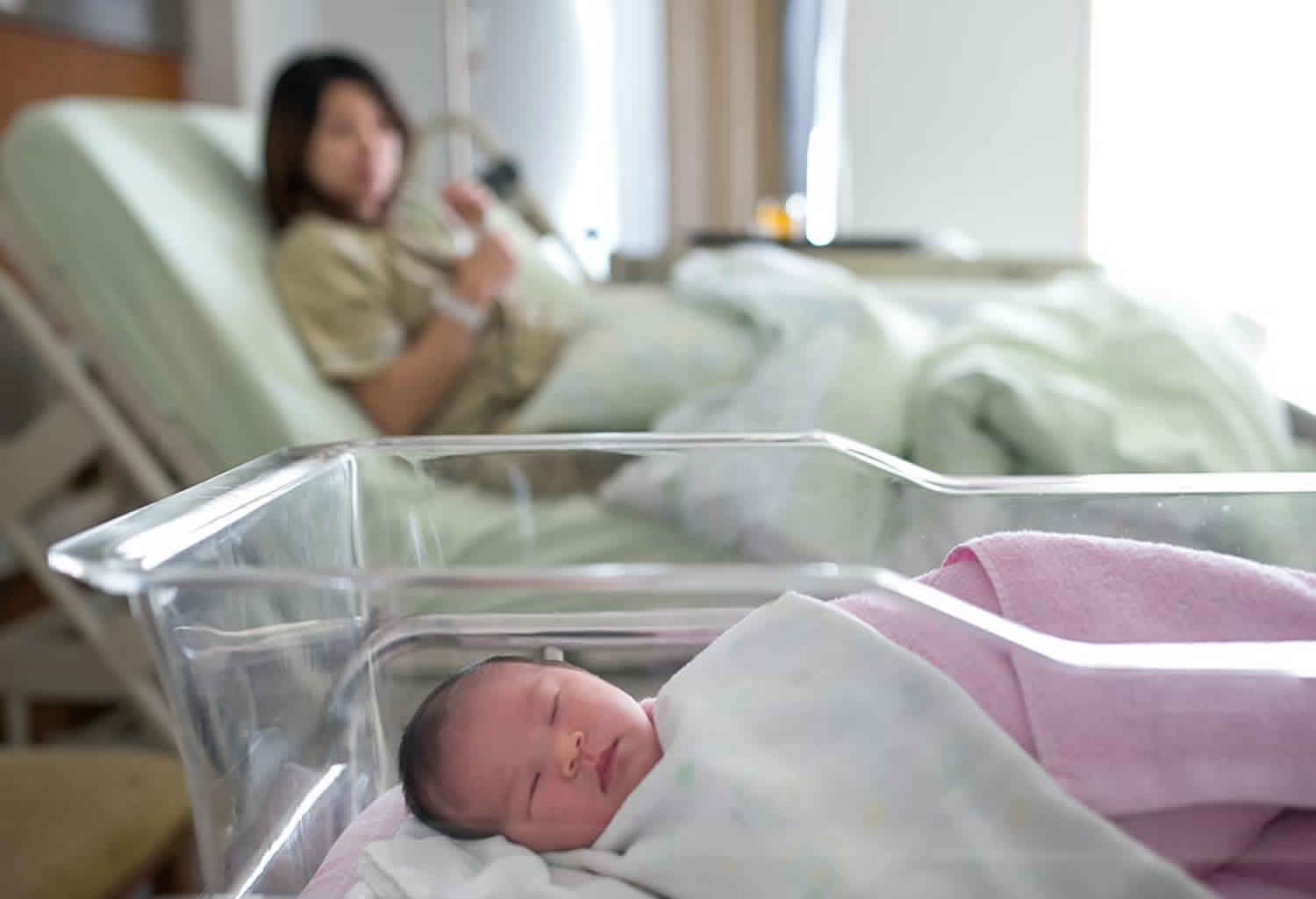Rooming-in
Rooming-in is the practice followed in hospitals and nursing homes where the baby’s crib is kept by the side of the mother’s bed (mother and baby together in the same room throughout hospitalization) 1. The practice of rooming-in as defined by the World Health Organization (WHO) and United Nations Children’s Fund is a “hospital practice where postnatal mothers and normal infants stay together in the same room for 24 hours a day from the time they arrive in their room after delivery” 2. Commonly, rooming-in is operationalized as a process in which mothers and their newborns stay together for at least 23 hours a day in the hospital 3. Rooming-in began as a way to promote early breastfeeding and encourage maternal–infant bonding. Hospitals who have implemented the Baby Friendly Hospital Initiative (BFHI) and the rooming-in policy have helped to increase the breastfeeding rates in the United States 4. Keeping mother and baby together by rooming-in is recommended as a healthy birth practice 5
Infants kept in a separate newborn nursery have been noted to receive significantly more breastmilk substitutes and significantly less breastmilk than babies who room-in with their mothers 6. Keeping mother and baby together can also increase confidence and be protective against stress related to change in parenting role for some mothers 7.
Although there are many benefits to rooming-in, it can be argued that there are also some disadvantages. Rooming-in may disrupt postpartum mothers’ sleep and therefore have a negative impact on their hospital stay and experience 8. There may be legitimate concerns about infant safety: that rooming-in could lead to bed sharing and other unsafe sleep practices 9. Logistical barriers such as a lack of appropriate infrastructure and resources may inhibit the adoption of rooming-in. Nurses and other clinicians may have a variety of concerns and may not necessarily support the practice of rooming-in 10.
There are many studies to support the fact that rooming-in increases breastfeeding rates 8. Yet, there are only a few articles that examine the sleep quality, rooming-in experiences, and overall patient satisfaction of postpartum mothers while still hospitalized 11.
Strategies to improve the Rooming-In experience of postpartum mothers
Nursing Care
- Orient the mothers to their rooms and the hospital routine.
- Suggested scripts 10:
- “No one will take your baby out of your room, it’s your baby.”
- “We will make sure the care happens in the room so we don’t separate you or your baby.”
- “We’re here to help.”
- Assess their overall knowledge of infant care and rooming-in.
- Provide appropriate patient teaching.
- Offer flexible choices.
- Provide adequate pain control.
- Provide extra support for cesarean birth and first-time mothers during the night.
- Demonstrate a positive attitude toward rooming-in.
Sleep
- Assess patients’ total hours of sleep each shift.
- Maximize comfort and promote good sleep hygiene—comfortable bed, dim light, quiet.
- Minimize unnecessary interruptions.
- Cluster care activities.
- Assist during nighttime awakenings of the infant.
Infant Safety
- Role model safe sleep for infants.
- Good lighting to monitor and examine infant
- “Nursery on Wheels” cart with supplies.
Rooming in breastfeeding
Breastfeeding is well known for its numerous benefits to both mothers and babies 12. The World Health Organisation (WHO) recommends a minimum six-month duration of exclusive breastfeeding for newborns 13. To promote and support breastfeeding, WHO and the United Nations Children’s Fund (UNICEF) developed the Baby-friendly Hospital Initiative (BFHI) 14. Baby-friendly Hospital Initiative (BFHI) consists of 10 steps to be practiced by maternity care facilities. Step 7 of these 10 steps is to practice rooming-in, allowing mothers and infants to remain together 24 hours a day. A baby who is not rooming-in with his/her mother would be cared for in a separate nursery, away from the mother from the time of leaving the delivery unit until discharge, during which, the mother may have access to feed her baby; or alternatively her baby may be brought to her for feeding 15. Rooming-in and nursery care are both traditional practices in many cultures, where they are considered to have their own advantages and disadvantages 16.
The recent update of the Cochrane Review, “Rooming-in for new mother and infant versus separate care for increasing the duration of breastfeeding”, (August 2016) 17, found no evidence to support either of the practices for improving breastfeeding outcomes. The authors included randomized control trials comparing 24-hour-per-day rooming-in with nursery care that reported breastfeeding outcomes. Out of the 19 relevant studies that were found, only one study was included. Of the 18 excluded studies, four were excluded because they were not randomized control trials, four had an intermittent rooming-in intervention 18, (such as daytime rooming-in), two did not have a nursery care group, six investigated the effect of early contact instead of rooming-in, one did not report relevant pre-specified outcomes and one further paper did not have sufficient information to be included or excluded.
The Cochrane authors chose to include only studies with 24-hours-per-day rooming-in thus making assumption that any rooming-in less than 24 hours per day would not provide breastfeeding protection. However, this notion has been queried and has been described as a rigid, oppressive and compulsory hospital routine 19. For example, maternal difficulty in resting and tiredness has been described as a drawback. If a dose-response effect existed, a shorter duration of rooming-in with intermittent separation, i.e. intermittent or flexible rooming-in, might also be beneficial 19. In other words, the examination of the evidence for intermittent rooming-in as well as continuous 24-hours-per-day rooming-in during hospital stay might add to the currently available body of evidence on the question of whether rooming-in has any effect on breastfeeding duration.
In a recent systematic review of randomized and non-randomized prospective controlled studies that included a total of seven studies on a total of 1366 infants. Overall, the study authors did not find any difference in full breastfeeding at 3, 4 or 6 months except for a small increase in proportion of infants on partial breastfeeding in the rooming-in group at 3–4 months of age 1. Uncertainty about the effects of rooming-in on breastfeeding duration remains. Further studies need to look at the other effects of rooming-in and nursery care. There is little data on the effect of these interventions on breastfeeding problems, maternal confidence or maternal satisfaction.
- Ng CA, Ho JJ, Lee ZH. The effect of rooming-in on duration of breastfeeding: A systematic review of randomised and non-randomised prospective controlled studies. PLoS One. 2019;14(4):e0215869. Published 2019 Apr 25. doi:10.1371/journal.pone.0215869 https://www.ncbi.nlm.nih.gov/pmc/articles/PMC6483355[↩][↩]
- The Ten Steps: Passed the Tipping Point and Moving Forward. https://www.babyfriendlyusa.org/news/the-ten-steps-passed-the-tipping-point-and-moving-forward[↩]
- Centers for Disease Control and Prevention. (2013). Breastfeeding report card. https://www.cdc.gov/breastfeeding/pdf/2013breastfeedingreportcard.pdf[↩]
- Early skin-to-skin contact, rooming-in, and breastfeeding: a comparison of the 2004 and 2011 National Surveys in Taiwan. Chiou ST, Chen LC, Yeh H, Wu SR, Chien LY Birth. 2014 Mar; 41(1):33-8.[↩]
- Care practice #6: no se paration of mother and baby, with unlimited opportunities for breastfeeding. Crenshaw J. J Perinat Educ. 2007 Summer; 16(3):39-43.[↩]
- The effect of Russian Maternity Home routines on breastfeeding and neonatal weight loss with special reference to swaddling. Bystrova K, Matthiesen AS, Widström AM, Ransjö-Arvidson AB, Welles-Nyström B, Vorontsov I, Uvnäs-Moberg K. Early Hum Dev. 2007 Jan; 83(1):29-39.[↩]
- The Effects of Single-Family Rooms on Parenting Behavior and Maternal Psychological Factors. Jones R, Jones L, Feary AM. J Obstet Gynecol Neonatal Nurs. 2016 May-Jun; 45(3):359-70.[↩]
- Theo LO, Drake E. Rooming-In: Creating a Better Experience. J Perinat Educ. 2017;26(2):79–84. doi:10.1891/1058-1243.26.2.79 https://www.ncbi.nlm.nih.gov/pmc/articles/PMC6353266[↩][↩]
- Deaths and near deaths of healthy newborn infants while bed sharing on maternity wards. Thach BT. J Perinatol. 2014 Apr; 34(4):275-9.[↩]
- Rooming-In-Are You Really? Merewood A. J Hum Lact. 2014 Aug; 30(3):268-269.[↩][↩]
- Separate care for new mother and infant versus rooming-in for increasing the duration of breastfeeding. Jaafar SH, Lee KS, Ho JJ. Cochrane Database Syst Rev. 2012 Sep 12; (9):CD006641.[↩]
- Ip S, Chung M, Raman G, Chew P, Magula N, DeVine D, et al. Breastfeeding and maternal and infant health outcomes in developed countries. Evidence report/technology assessment. 2007;(153):1–186.[↩]
- Kramer MS, Kakuma R. Optimal duration of exclusive breastfeeding. Cochrane Database of Systematic Reviews. 2012;(8):CD003517 10.1002/14651858.CD003517.pub2[↩]
- World Health Organization. Ten steps to successful breastfeeding (revised 2018). Geneva: WHO, 2018. https://www.who.int/nutrition/bfhi/ten-steps/en/[↩]
- Hillier K. Babies and bacteria: phage typing, bacteriologists, and the birth of infection control. Bulletin of the history of medicine. 2006;80(4):733–761. 10.1353/bhm.2006.0130[↩]
- Thomas LM. The changing role of parents in neonatal care: a historical review. Neonat Netw. 2008;27(2):91–100.[↩]
- Jaafar SH, Ho JJ, Lee KS. Rooming-in for new mother and infant versus separate care for increasing the duration of breastfeeding. The Cochrane database of systematic reviews. 2016;(8):Cd006641 10.1002/14651858.CD006641.pub3[↩]
- Kucera H, Kubista E. [Partial “rooming-in”—a model from the I department of gynecology and obstetrics, university of Vienna (author’s transl)]. Geburtshilfe und Frauenheilkunde. 1979;39(10):905–909.[↩]
- Rice P. Rooming-in and cultural practices: Choice or constraint? Journal of Reproductive and Infant Psychology. 2000;18(1):21–32.[↩][↩]





